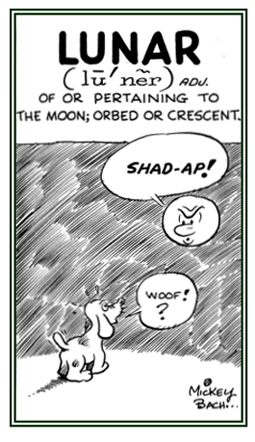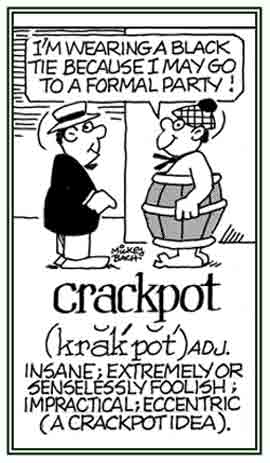luna-, luni-, lun-, lunu-
(Latin: moon, light, shine)
2. Concerning something belonging to the moon or situated in the moon, formally supposed to be influenced by or dependent upon the moon: Greg read about the lunar landscape which showed pictures of some of its craters and natural depressions on its surface.
3. Relating to a moon or its movement around a planet, especially the moon in relation to the Earth: Some people rely closely on a lunar month for planting certain vegetables or flowers.
4. Pertaining to something that is used in space travel or anything used on the moon: When the astronauts landed on the object similar to a planet which goes around the Earth, they used lunar vehicles to move about on its surface.
5. Descriptive of something like the moon, especially being pale, pallid, orbed, or round: Susan wore a dress of dark blue with lunar trimmings in gold and shaped like crescents.
6. In mythology and science fiction, concerning an inhabitant of the moon: In the book Steven was reading there was a dweller on the Earth's natural satellite and was described as being the lunar man!
For more details, click on this Calendar, Moon Phases unit so you can see more details about the aspects of the moon.

Go to this Word A Day Revisited Index
so you can see more of Mickey Bach's cartoons.
On December 21, 2010, the full moon (besides distinguishing itself from the others in 2010 by having undergone a total lunar eclipse) also took place on the same date as the solstice (the winter solstice if north of the equator, and the summer solstice if south of the equator.
The winter solstice is the shortest day of the year in the Northern Hemisphere and marks the official beginning of winter. The sun is at its lowest in the sky because the North Pole of our tilted planet is pointing away from it.
How does the December full moon coincide with the solstice? Before this year, there were solstice full moons in 1999 (December 22) and 1980 (December 21).
After this year of 2010, it will be a long time until there is another December full moon on the same date as the solstice; that is, December 21, 2094!
Just like this year, that same full moon will fall into earth's shadow in a total lunar eclipse; however, unlike this year, the 2094 eclipse will not be visible from the Western Hemisphere.
It will be available for seeing, weather permitting, from Europe, Africa and much of Asia.
Prior to 2010, when was the last time that we had a total lunar eclipse occur on the same calendar date as the winter solstice? The answer, incredibly, takes us back nearly four centuries when on December 21, 1638, the full moon was in total eclipse.
Facts about total lunar eclipses
- The Moon is currently moving away from earth by about 1.6 inches (4 centimeters) every year.
We happen to stand on planet earth at a time when the moon's apparent size in the sky is exactly the same as that of the sun.
The moon's actual diameter is much smaller than the sun, but it is much closer to us; eventually, however, a total lunar eclipse won't be geometrically possible, just as it as not possible in the distant past when the moon was closer to us.
- Columbus knew that lunar eclipses didn't go on forever.
Astronomers say no lunar eclipse can last more than three hours and forty minutes; so, when the moon is completely immersed in the earth's shadow, it cannot go on for more than one hour and forty minutes.
The period of totality for the October 27, 2004, eclipse was one hour and twenty-two minutes.
An eclipse on November 8, 2003, laste just twenty-five minutes. Why is there such a difference?
The earth's shadow is cone-shaped; so, we need to see a slice of it, a two-dimensional circle through which the moon can pass.
Longer stretches of an eclipses mean the moon is going across the center of the circle. Shorter total eclipses take plac when the moon's path is closer to the top or the bottom of the shadow.
- When the moon disappeared in 413 B.C., Athenians saw it as a bad omen and delayed their planned retreat from the Sicilian city of Syracuse, where they had fought for two years in the Peloponnesian War.
The Syracusans used the delay as an opportunity to break the siege, apparently contributing to the fall of Greek civilization.
Christopher Columbus actually used an eclipse to alter history. Stranded in Jamaica in 1503, on his fourth voyage, Columbus and his crew were wearing out their welcome with the natives, who were feeding them.
Columbus knew a lunar eclipse was coming, so he "predicted" the moon's disappearance and the natives begged him to bring it back and, of course, he did.
- The mysterious arrangement of boulders in Stonehenge, England, has long been associated with celestial meanings; however, scientists have struggled to figure out what the meaning was for the people who erected the stones about 3,500 years ago.
One purpose may have been to predict lunar eclipses. In the year 2000, a researcher who had been studying Stonehenge for twenty years stumbled upon the observation that if a person placed stone markers at strategic locations on top of 19 columns in the arrangement, a known 47-month cycle of lunar eclipses would become apparent.
- In Japan, some people still cover wells to avoid being poisoned by the disease of the moon during an eclipse.
Native residents of the Arctic regions have been known to turn over their utensils to avoid contamination.
In other cultures, people yell at the moon during an eclipse, or they bang pots or even shoot into the air.
- For people of ancient times, eclipses were considered to be abnormal and incomprehensible, even terrifying.
Some cultures saw lunar eclipses as signs of celestial wrath that could result in famine or disease.
The Chinese word for eclipse is chih, which means "to eat"; so a person can imagine that the bloody cast of the moon in some eclipses only added to the fear of what was going on.
Even into the 19th Century, the Chinese navy fired cannons to scare off the dragon they imagined was eating the moon.
- When the earth experiences a total lunar eclipse, things get interesting on the moon, too.
If you were there, on the side facing the earth, the earth would block out the sun and the sun's light would not completely disappear.
The earth would be ringed by light scattered through its atmosphere because the sun would be hidden behind a dark earth outlined by a brilliant red ring consisting of all the world's sunrises and sunsets.
The light refracted by all of these sunrises and sunsets can fall on the moon, giving it a red glow instead of it completely disappearing. Each eclipse is different, however, and some yield little of this reddening effect.
- Lunar eclipses are common compared to solar eclipses, at least in one sense.
Solar eclipses are fairly numerous, generally two to five per year, but the area on the ground covered by totality is only a few tens of miles (and kilometers) wide; so, it's rare to be in the path of a total solar eclipse.
In any given location on earth, a total solar eclipse happens only once every 360 years. Lunar eclipses are less frequent, but total lunar eclipses are visible everywhere it is nighttime as the event takes place; about half the globe.
Any given location on earth can experience up to three lunar eclipses per year, as last happened in 1982. Some years there are none, as in both 2005 and 2006.
- Since lunar eclipses always occur at full moon, it makes sense to ask why each full moon does not generate a toal eclipse.
Eclipses are relatively rare because the plane in which the moon orbits around earth is tilted five degrees compared to the plane of earth's travels around the sun, a plane that astronomers call the ecliptic.
The geometry of any eclipse, the relative positions of the sun, earth and moon, is repeated during a set of complex cycles that last just a little more than eight years.
This Saros cycle, as the whole thing is called, explains the bunching of eclipses, too. Astronomers have figured it out and can predict eclipse timing and circumstances far into future.
- The cause of lunar eclipses is simple: the earth gets in the way.
The moon is a shiny beacon because it reflects sunlight and the moon makes no light of its own.
The earth always casts a shadow into space, and every now and then everything aligns just right so that the shadow falls on the moon.
Lunar eclipses can only occur at full moon, that time each month when the moon is directly opposite the earth in relation to the sun.
2. Someone who observes or describes the moon; such as, anyone who used the lunar method in finding longitude.
3. Someone who observes or describes the moon.
2. The descriptive science relating to the moon; also, selenography.
2. Monthly, menstrual period.
3. Someone born under the influence of the moon.
4. A crescent or half-moon.
2. Of or relating to the moon.
3. A small prehistoric stone (usually flint) artifact that was probably used as an arrow-head and has an elongated half-moon shape with the straight edge unworked and the curved edge sharpened by chipping.
4. A person of unsound mind; a madman or a crackpot.

Go to this Word A Day Revisited Index
so you can see more of Mickey Bach's cartoons.
5. Etymology: "affected with periodic insanity, dependent on the changes of the moon", from Old French lunatique, "insane"; from Latin lunaticus, "moon-struck", from luna, "moon".
Etymologically related "light, shine, glow" word families: ethero-; fulg-; luco-; lumen-, lum-; lustr-; phengo-; pheno-; phospho-; photo-; scinti-, scintill-; splendo-.
A cross reference of word units that are related, directly or indirectly, to the: "moon": Calendar, Moon Facts; Chemical Element: selenium; Gods and Goddesses; Luna, the earth moon; menisc-; meno-; Planets in Motion; plano- seleno-.


